Period:
Yugoslav Wars
Region:
Bilogora
The Croatian crime in Bjelovar - Bilogora 1991
The crime in Bjelovar was committed by members of the Croatian paramilitary units and Croatian police on September 29, 1991 in Bjelovar’s barrack of the Yugoslav Federal Army (JNA) “Božidar Adžija”.
At first, several officers were captured and killed. Stojadin Mirković, a JNA soldier was killed in transporter while he was defending barrack. Major Milan Tepić activated explosive blowing up himself and ammunition store.
This act reminded Serbs of brave act of Stevan Sindjelić, hero from the First Serbian Uprising, who opened fire on a powder keg blowing up himself together with thousands of Ottoman Turks.
The Croatian Prosecutor’s office and courts conducted improper investigation against suspects with no final judgment being made for this case. Hague Tribunal has never shown interest in prosecution of criminals from Bjelovar.
BACKGROUND
SFR Yugoslavia was a federal state made up of 6 republics (FR Slovenia, FR Croatia, SR Bosnia, and Herzegovina, SR Montenegro, SR Serbia, and SR Macedonia). Both Yugoslavia and the JNA were established on the principle of “brotherhood and unity” of all peoples and nationalities who lived in the SFRY.
The social and economic system of the SFRY was socialism.
The 1974 Constitution of Yugoslavia brought about the decentralization of the SFRY, which later enabled the separatist forces in Slovenia and Croatia, and later in Bosnia and Herzegovina to begin the dissolution of Yugoslavia, followed by bloody wars and persecution.
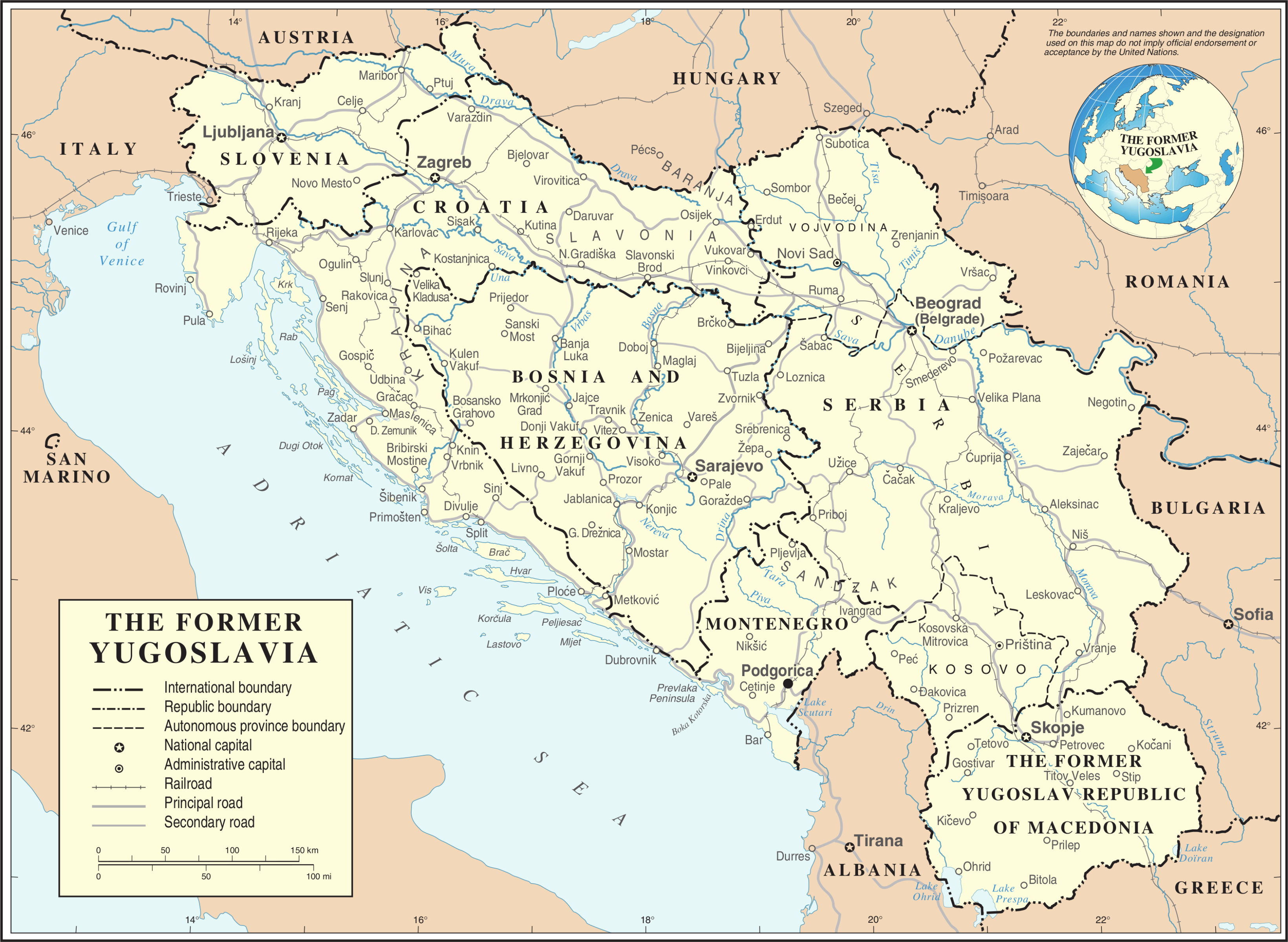
In all the constitutions of Yugoslavia, the Yugoslav People's Army was defined as the only legitimate armed force in the territory of the SFRY, and therefore, the only internationally recognized military entity. At the end of 1989, the SFRY Assembly passed amendments to the Constitution, thus replacing the one-party system with the multiparty system, which meant that besides the Alliance of Communists of Yugoslavia, other parties could now be formed.
At the end of January 1990, the Alliance of Communists of Yugoslavia collapsed, at the 14th SKY Congress in Belgrade, when sharp verbal clashes between Slovenian and Serbian delegates occurred regarding the future of the joint state of the SFRY.

Opposing sides - Kučan and Milosević
The Slovenian delegation left the session, immediately followed by the delegation of the FR Croatia, which brought the issue of the congress into question. After them, the delegations of the FR of Bosnia and Herzegovina and the FR of Macedonia also left the congress.
Thus, after 45 years, the rule of the communists in SFRY ended.
The situation in FR Croatia
On the multi-party elections held in FR Croatia on 22 April 1990, the HDZ party won with its political program clearly stating the desire for independence and separation of FR Croatia from SFRY.

Collaborators against the Serbs: Tudjman and Račan
The victory sparked great euphoria throughout the Federal Republic of Croatia and displays of images of Ustasha criminals (Ante Pavelić, Alojzije Stepinac, Vjekoslav Luburić, and others), while Ustasha greetings and Ustasha songs could be frequently heard. This brought back memories of Serbs in SR Croatia of persecution and genocide in the Independent State of Croatia (The Nazi project between 1941-1945).
As early as spring, the HDZ and Franjo Tudjman took control of the police, the media, the prosecution and the state administration. Serbs working in the police were forced to leave in the spring of 1990 immediately after taking over the power, when the conflict at Maksimir (Zagreb's football stadium) between fans of NK Dinamo (Croatia) and FC Red Star (Serbia), were misused for anti-Serb propaganda.
Thus began a media war against everything that had to do with Serbia and Yugoslavia. In summer, the authorities of the FR Croatia in Zagreb made the decision to form the armed forces themselves. In October and November 1990, a large amount of weapons were illegally imported into the Federal Republic of Croatia for the needs of the reserve police forces, members of the HDZ and the VOC. The action was led by Martin Špegelj and Josip Boljkovac, ministers in the then government of Croatia.
Illegal arming of Croats
The JNA Counterintelligence Service made a film about this endeavor at the JNA military training polygon in Gakov in October 1990 and released it on TV Belgrade on 27 January 1991. On 22 December 1990, a "Christmas Constitution" was solemnly proclaimed in the Parliament, by which the Serbs lost their decades-old constitution rights and Croatia removed the name "socialist" in its name.
Since May 1990, the situation in FR Croatia started worsening day by day and the Serbs were terribly scared for their personal security and their property. Ustasha graffiti, slogans, posters could be seen regularly, and a large number of Serbs received threats by phone that they had to move out of their homes and go to SR Serbia. They even received threatening letters bearing the "HDZ" signature.
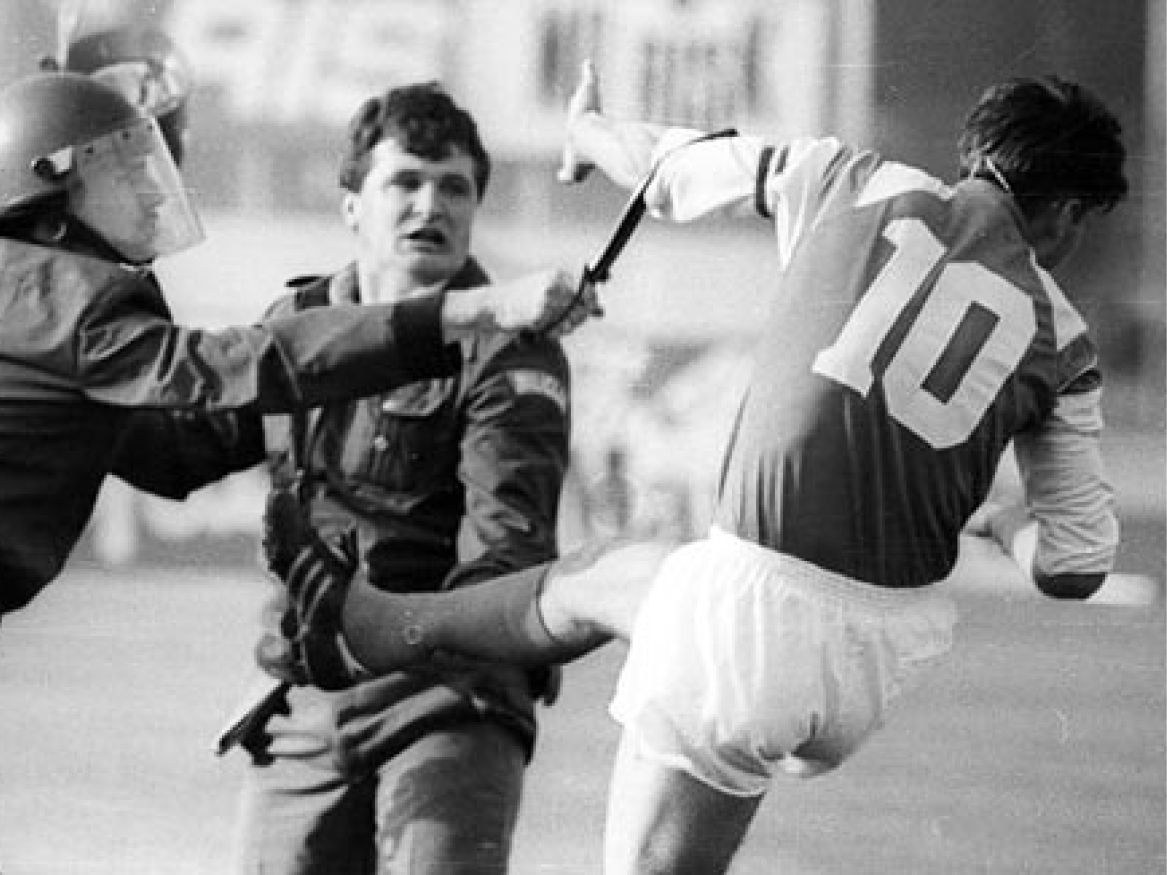
Violence in Zagreb at the Maksimir stadium
Even Croats who were married to Serbs received such threats.
Serbs in Croatia were fired from their jobs, and even their children were mentally and physically abused in schools. In almost all settlements where Croats had an absolute or relative majority, there were certain members of the HDZ party who had a task to keep an eye on the movement of their Serb neighbors (espionage).
ATTACK PREPARATION
In all cities of the Federal Republic of Croatia where barracks of JNA were located, JNA soldiers and officers were being provoked and attacked by Croatian people. Local authorities would turn off water and electricity supply, prevent food delivery to barracks, etc.
These barracks mostly held soldiers on regular military service. Soldiers and officers of JNA of Croatian and Slovenian nationality regularly deserted from JNA starting from May, 1991. Many of them just returned home, but many joined ZNG or special police units.
The Bjelovar’s JNA barrack “Božidar Adžija” held the 256th motorized brigade of JNA. This brigade was under control of the Fifth Military District whose command was in Zagreb. Croatian paramilitary forces attacked the JNA barrack “Božidar Adžija” on September 28, 1991. They aimed at seizing barrack and gaining control over the large ammunition store which was located in a forest “Bedenik” near the barrack.
This action was led by Jure Šimić, a JNA ex-officer who joined ZNG. At the time he was president of the so called the Crisis Headquarters in Bjelovar.
The Command of JNA barrack “Božidar Adžija” sent urgent letter to its superiors in the Command of the Fifth Military District in Zagreb, seeking help after they saw they had been besieged by ZNG members. At the moment, there were 150 soldiers and 70 officers of JNA in the barrack. They were outnumbered by ZNG who had around 1000 armed members.
Instead of sending help, the Command from Zagreb sent the Observation Mission of European Community who should have acted as a peace mission preventing conflict outbreak. Members of the Observation Mission of EC weren’t allowed to enter the JNA barrack.
THE CRIME
Early in the morning of September 29, 1991, around 7:00, members of ZNG started severe attack on the JNA barrack “Božidar Adžija”, and defense of the barrack was led by Colonel of JNA Rajko Kovačević. They used heavy weapons, tanks. Soldiers of JNA were placed at designated locations for defense of the JNA barrack, according to previously determined plan made by JNA major Milan Tepić.
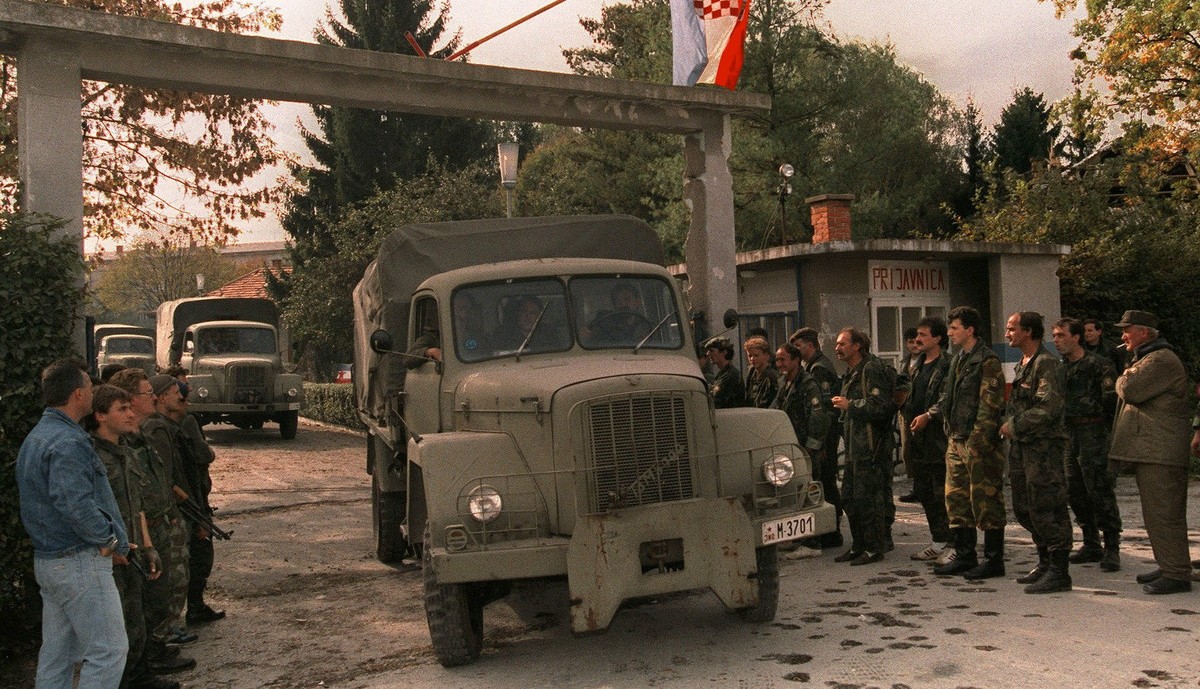
Leaving JNA Barrack in Bjelovar
When Croatian paramilitary forces started with the attack, it prompted strong defense action of the barrack and store which was led by JNA soldier Stojadin Mirkovic on his transporter. Conflicts over the JNA barrack “Božidar Adžija” silenced in the afternoon of the same day. JNA colonel Rajko Kovačević ordered his soldiers to stop with defense and lay their weapons down.
After that, Croatian paramilitary members entered and seized the barrack. Jure Šimić arranged JNA officers and soldiers in a row ordering them to get naked to the waist. He took out JNA officers of the row: Colonel Rajko Kovačević, lieutenant colonel Dragiša Jovanović and commander of the 1st Class Miljko Vasić, took them 50m away and killed them personally with two shots at each officer.
Six soldiers of JNA: Radovan Barberić, Zdravko Dokman, Radovan Gredeljević, Ivan Hosjak, Boško Radonjić, and an anonymous person were captured and taken to the police office in Bjelovar.
After the end of the conflict, ZNG members went to find the store in the forest which was mined. Major Milan Tepić saw them entering and activated a switch causing 170 tonnes of explosive to explode. Together with him, seven soldiers of JNA were killed, but 200 ZNG members as well.
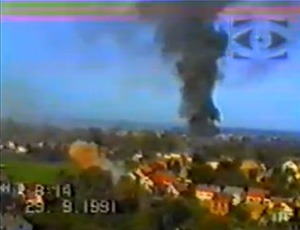
On the next day, Croatian civilians from Bjelovar entered the occupied barrack urinating and spitting on dead soldiers of JNA.
Six soldiers of JNA, who were captured in the police station in Bjelovar were taken to the forest “Česma” on October 3, 1991 near the place Malo Korenovo and killed. The only person that survived was Savo Kovač, a Serb civilian from Bjelovar, who had been falsely accused of being sniper and arrested the day earlier. He later gave testimony about this crime.
AFTERMATH
At the end of 1991, Milan Tepić was proclaimed a national hero by truncated presidency of SFRJ. Several streets in the Republic of Serbia and Republic of Srpska were named after Milan Tepić. Serbian people extolled Milan Tepić in numerous epic poems comparing him with Stevan Sinđelić, a Serbian hero from First Serbian Uprising.
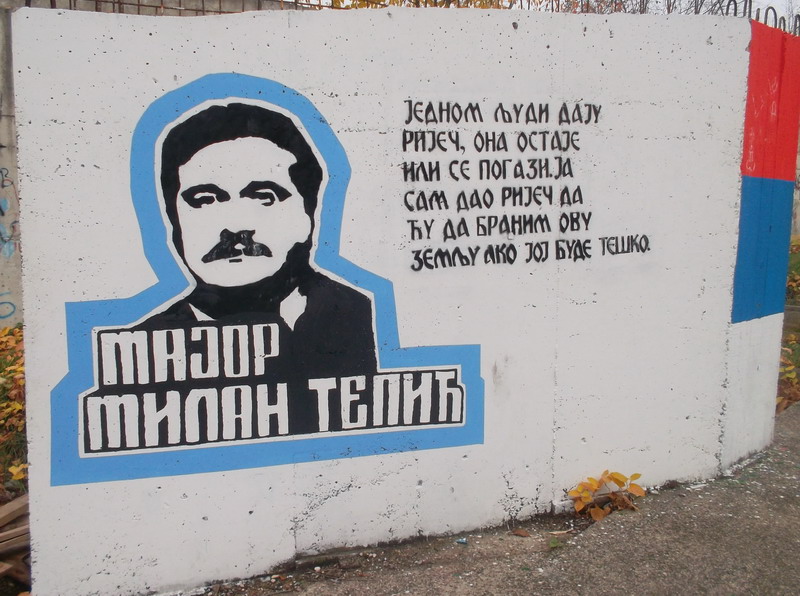
Mural of Major Milan Tepic in Banjaluka
Soldier Stojadin Mirković was posthumously honoured with “the 1st Class of the Order of Merit in the field of defense and security.” A street in city of Valjevo (Serbia) was named after him. In the Elementary School which he attended, Stojadin Mirković received a monument on September 28, 2013.
September 29 is celebrated in Bjelovar as the Day of the Town.
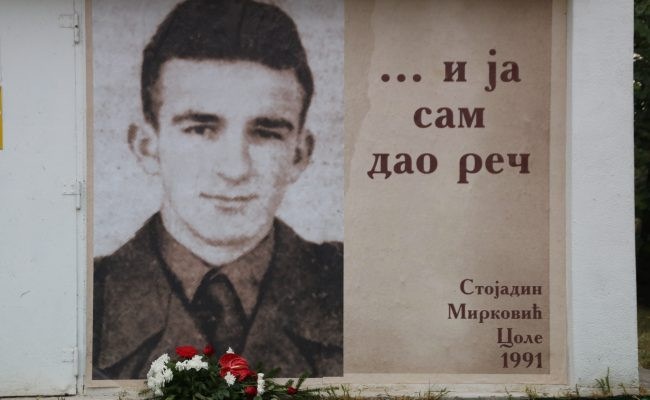
Mural of solider Stojadin Mirkovic in Belgrade
After this conflict, Croatia was rapidly entering the war which was the aim of Croatian authorities. This coincided with the statement of Franjo Tuđman at the Jelačić piazza on May 30, 1992 that Croatia could have received independence without war, but that it wouldn’t have become ethnically clean.
TRIAL AND JUDGMENTS
Croatian Parliament enacted the Law on Absolution in 1992, by which all members of HOS, HDZ, the Ministry of Interior of the Croatian Republic, and ZNG were pardoned for war crimes.

The organizer of the crime cro war criminal: Jure Šimić
The Prosecutor’s office of JNA raised indictment in 1992 against Jure Šimić and his assistants for murder of soldiers and officers of JNA in Bjelovar on September 29, 1991.
Family of JNA officer Dragiša Jovanović sent official request in 1998 to the Hague Tribunal to open investigation against Jure Šimić, but the Prosecutor's office of the Tribunal has never opened investigation process against Jure Šimić.
The State Attorney’s Office raised indictment on September 21, 2001 against four members of the Croatian police from Bjelovar: Luka Markešić, Zdenko Radić, Zoran Maras and Ivan Orlović for committing criminal act of murder of six war prisoners and for attempt of murder of a civilian on October 3, 1991 in the forest “Česma”.
Defendants were unlawfully released two times, first in 2001, and second time in 2005 “due to the lack of evidence”. The Croatian Supreme Court has abolished both acquittals.
In May, 2006 The Hague Tribunal sent indictments to the District Attorney’s Office in Bjelovar against persons accused of murder of JNA soldiers in the barrack in Bjelovar. The investigation on war crimes against N.N persons has been initiated. RTS (Radio Television of Serbia) broadcasted video material of crimes committed against JNA soldiers in the barrack.
The District Court in Varaždin initiated the third trial against four members of the Ministry of Interior of Croatia in September, 2007 and the Prosecutor’s Office changed the indictment this time in which they were accused of assisting and participating in the war crime against war prisoners and civilians. Non-final decision was made on December 21, 2007, which found the accused guilty, with one person being sentenced up to 4 years of prison and three persons up to 3 years, which is below of legal minimum. The Supreme Court in Croatia abolished this decision in 2010, as well.
The District Attorney and Court initiated investigation against Jure Šimić in November 2010 for “reasonable doubts on criminal acts of war crime against war prisoners.” The investigation on this crime still hasn’t been finalized. Jure Šimić spent 11 days in prison, but then released to defend himself out of prison. The case was assigned to the District Court in Rijeka.
The Council for war crimes in Belgrade sent indictments to the Croatian State’s Attorney on October 24, 2011 against persons suspected of war crimes against Serbs in Croatia during the period 1991-1995. These indictments and decisions made by legal bodies of SFRJ, JNA and Serbia were declared void by the Croatian Parliament.
The District Court in Zagreb initiated trial against four members of the Ministry of Interior of Croatia from Bjelovar in 2011. On November 17, 2011 the judgment was made, releasing them with statement that “acts which they were charged with are not criminal acts”.
Since nobody submitted complaint, the judgement became final.
NAME OF VICTIMS
Names of soldiers Yugoslav Federal Army's that were killed:
|
1.Milan Tepić, 1957
2. Stojadin Mirković, 1972
3. Rajko Kovačević
4. Dragiša Jovanović
5. Miljko Vasić
6. Radovan Barberić
|
7. Zdravko Dokman
8. Radovan Gredeljević
9. Ivan Hosjak
10. Boško Radonjić
11. Ranko Stefanović
|
Tags:
Please, vote for this article:
Visited: 3354 point
Number of votes: 16
|